- Details
-
Created: Saturday, 02 May 2009 05:16
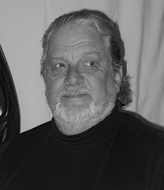 The word, “workmanship” in the title of this book may have raised your curiosity. If I then told you that the author, David Pye, was Professor of Furniture Design at the Royal College of Art, London, you might be scratching your head wondering, “What does this have to do with stone sculpture?” Let me explain. In addition to his role as Professor of Furniture Design, Pye was also an architect, industrial designer and master craftsman. During his long and illustrious career, he devoted a great deal of thought to process of design and the execution of those designs. In recognition of the corruption of the terms “craft” and “craftsmanship” over the years, he dismisses them, and proposes new (and probably more useful) terminology – the ‘workmanship of risk’ and the ‘workmanship of certainty,’ Workmanship of risk means a quality of work dependent on the judgment, dexterity and care with which one works, and workmanship of certainly involves predetermined results before a thing is made, such as in automated production. Risk carries with it the chance that any work piece could be damaged or destroyed at any step in its handling and does not matter whether the tool is a simple hammer or complex milling machine. Either a reliable process or fallible workman defines the result.
The word, “workmanship” in the title of this book may have raised your curiosity. If I then told you that the author, David Pye, was Professor of Furniture Design at the Royal College of Art, London, you might be scratching your head wondering, “What does this have to do with stone sculpture?” Let me explain. In addition to his role as Professor of Furniture Design, Pye was also an architect, industrial designer and master craftsman. During his long and illustrious career, he devoted a great deal of thought to process of design and the execution of those designs. In recognition of the corruption of the terms “craft” and “craftsmanship” over the years, he dismisses them, and proposes new (and probably more useful) terminology – the ‘workmanship of risk’ and the ‘workmanship of certainty,’ Workmanship of risk means a quality of work dependent on the judgment, dexterity and care with which one works, and workmanship of certainly involves predetermined results before a thing is made, such as in automated production. Risk carries with it the chance that any work piece could be damaged or destroyed at any step in its handling and does not matter whether the tool is a simple hammer or complex milling machine. Either a reliable process or fallible workman defines the result.
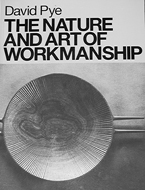 As Pye says, “Bad workmanship is a matter of making mistakes through hurry, carelessness or ineptitude, which thwart the design.”
As Pye says, “Bad workmanship is a matter of making mistakes through hurry, carelessness or ineptitude, which thwart the design.”
Through many examples, photographs and theory, Pye explains how to judge the value of work – whether one’s own or that of others. In his down-to-earth writing style, he shows how to judge good workmanship from bad, Further, he distinguishes “regulated” from “free” fabrication where fine tolerances and precise geometries characterize regulated fabrication; whereas free fabrication allows the worker to vary the workpiece for aesthetic reasons.
Without mentioning stone sculpture directly, everything Pye discusses has relevance for our craft. His book might lead to some interesting discussions over the camp fire at one of our symposia. It would certainly generate thoughtful ruminations in our own studios.
- Details
-
Created: Monday, 02 March 2009 04:53
Driving directions to Art City are easy you say? Ha! They go something like this: Take the California St. exit off of the 101 freeway. Drive east to Main St. then go north on Main to Olive, turn east on Olive and go two blocks, now go left on Dubber St., only the sign says Rex St. Look closer, there’s a small arrow above the Rex St. sign that points up Rex St. 150 ft. to Dubber. Okay, now turn right.
But it’s a dead end street; keep going anyway. Pass an old VW auto yard and car body shop. And then, look over there: large basalt columns, naturally formed basalt bowls and Kansas limestone fence posts along the fence, and a big sliding gate. Art City, at last.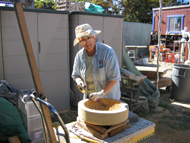
To any stoner worth their salt, the place is Fantastic. One can see huge blocks of marble in many different colors, piles of travertine and several types of limestone. I saw a lot of alabaster and onyx as well as many stones I don’t have names for.
There are work areas with roughed out and almost finished sculpture, and an open-air showroom with beautiful finished works of art. Naturally there is a layer of fine stone dust on everything. This is a working stone yard for a dozen or more sculptors.
Art City wasn’t really planned, it evolved. Paul Lindhard had been teaching stone art for some time at Santa Barbara City College and dragging his more than willing students along for field trips out to the desert and mountains of Arizona and California.
These trips were to find stone for carving. And, of course, all stone carvers end up feeling obligated to leave no good stone behind, so it wasn’t long before Paul saw the need for a space to store the surplus tons.
Real Estate growth in the Santa Barbara area being what it was he had to look farther afield. In l985 he and his brother leased an acre plus in a commercial area of Ventura, a town thirty miles to the south on the Coast Highway. That lot was the beginning of Art City.
At first ten or so students shared simple sculpting space. Then hoists were added, they found a forklift and installed a big air compressor. A couple of years later Paul leased another half block of property close by, and that became Art City II, providing room for more artists. In 1988 Joanne Duby came to work in a studio there. 1990 Russell Erickson came to work with Paul, and is now a partner. Alexandra Morosco arrived in 1994.
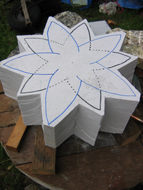
It seems to me that when good fortune was handed out, I must have been pretty close to the front of the line. For the second year in a row I have been able to spend two of our cold winter months at Art City, hosted by Paul and Russell and guided by my good friend and mentor Joanne.
My husband, Mike, and I lived in our fifth wheel trailer in an RV Park just a 15 minute walk to the studio. And other than a couple days of heavy rain, the weather was ideal for working. And work I did. Joanne is a no nonsense task master. We worked seven day a week from 9:30 to 5:00 most days. I was given a wonderful spot beside the water fountain display and under the shade of a beautiful blooming plum tree. Each morning, white blossoms lay on my work tables.
The project I decided to work on this year is an Art Deco style piece. I combined 4 different types of stone into one sculpture using pins and sleeves for ease of transport and assembly. Throughout the work I had help and guidance from Joanne, Paul and Russell.
When fully assembled, my stacked up sculpture will be over 4 feet tall. The base element is a core cylinder 18” across and 9” high made from 150 pounds of Saudi Gold limestone. Its color is like 24K old gold. The stem is a 30” tall 6” round core of black-gray and gold Portoro Marble. This is topped by a ten petal Lily of white with gray flecks, Ordenario Marble, 20” across by 9” high. In the center of the Lily will be a five pound, 8” bud of bright blue Lapis Lazuli.
At Joanne’s advice I have tried to keep a good photo history of the progress of the piece. I hope to complete the sculpture before my 72nd birthday this October.
For the last several years, NWSSA’s Camp Brotherhood Symposium has been the recipient of a lot of Art City stone. Unfortunately with the economy being what it is and fuel cost so high, they were not able to join us in 2008 and won’t be there this year either. We miss them.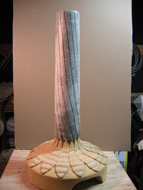
So, if you are looking for a bit of Stoner adventure, give Russell or Paul a call at 805-648-1690 for space cost and more info. You DO need to bring your own tools. But my goodness, don’t bother to lug stone along; they have plenty to choose from at Art City.
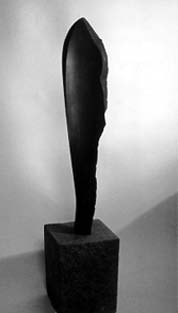
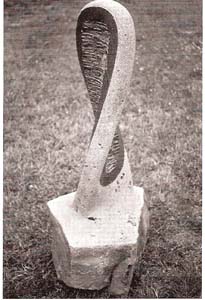

 The word, “workmanship” in the title of this book may have raised your curiosity. If I then told you that the author, David Pye, was Professor of Furniture Design at the Royal College of Art, London, you might be scratching your head wondering, “What does this have to do with stone sculpture?” Let me explain. In addition to his role as Professor of Furniture Design, Pye was also an architect, industrial designer and master craftsman. During his long and illustrious career, he devoted a great deal of thought to process of design and the execution of those designs. In recognition of the corruption of the terms “craft” and “craftsmanship” over the years, he dismisses them, and proposes new (and probably more useful) terminology – the ‘workmanship of risk’ and the ‘workmanship of certainty,’ Workmanship of risk means a quality of work dependent on the judgment, dexterity and care with which one works, and workmanship of certainly involves predetermined results before a thing is made, such as in automated production. Risk carries with it the chance that any work piece could be damaged or destroyed at any step in its handling and does not matter whether the tool is a simple hammer or complex milling machine. Either a reliable process or fallible workman defines the result.
The word, “workmanship” in the title of this book may have raised your curiosity. If I then told you that the author, David Pye, was Professor of Furniture Design at the Royal College of Art, London, you might be scratching your head wondering, “What does this have to do with stone sculpture?” Let me explain. In addition to his role as Professor of Furniture Design, Pye was also an architect, industrial designer and master craftsman. During his long and illustrious career, he devoted a great deal of thought to process of design and the execution of those designs. In recognition of the corruption of the terms “craft” and “craftsmanship” over the years, he dismisses them, and proposes new (and probably more useful) terminology – the ‘workmanship of risk’ and the ‘workmanship of certainty,’ Workmanship of risk means a quality of work dependent on the judgment, dexterity and care with which one works, and workmanship of certainly involves predetermined results before a thing is made, such as in automated production. Risk carries with it the chance that any work piece could be damaged or destroyed at any step in its handling and does not matter whether the tool is a simple hammer or complex milling machine. Either a reliable process or fallible workman defines the result.  As Pye says, “Bad workmanship is a matter of making mistakes through hurry, carelessness or ineptitude, which thwart the design.”
As Pye says, “Bad workmanship is a matter of making mistakes through hurry, carelessness or ineptitude, which thwart the design.”


